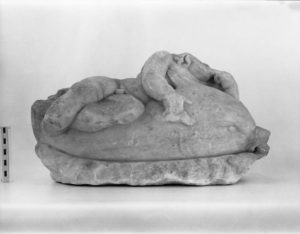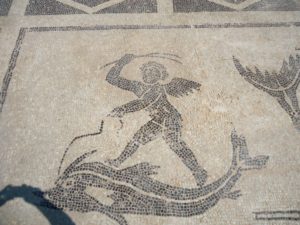
“Fleeing [her husband Athamas], Ino threw herself into the sea with her child Melicertes from the Molurian Rock.” (Paus. 1.44.8)
Such a sentence ostensibly announces the ending to a story, but in fact, it is only the beginning. After their horrific plunge off the craggy cliffs, it would seem that death is the only possible result. Yet the child is rescued by a dolphin and their transformation and rebirth is signified by their new names, Leucothea (white goddess) and Palaimon (the wrestler). Who are this mother and child? Why does Ino throw herself and her son into the sea? Why does Pausanias give the reader details of the story piecemeal rather than all at once? And why is this story so important to the isthmus and to the identity of the Corinthia?
Pausanias gives us hints about what caused Ino’s flight. He reports that Athamas killed his older son Learchus for one of two reasons, insanity or rage. Pausanias’ readers would immediately remember the two versions of the story. According to the first, Hera, enraged that Athamas and Ino had nursed the infant Dionysus, causes Athamas to go mad and kill his older son Learchus. Ino and Melicertes flee the deranged Athamas and throw themselves into the sea (Ovid, Met. 4.416-542; Apollodorus 1.9.2, 3.4.3; Hyginus 1-2).
According to the second, after the death of Athamas’ first wife Nephele, Ino plots against Nephele’s children, Phrixus and Helle. She persuades the women of

Orchomenus to cause a famine by parching the seeds before they are planted. When Athamas sends messengers to Delphi to understand why famine had come upon the land, Ino bribes the messengers to say that in order to bring an end to the famine, the children Phrixus and Helle must be sacrificed. Discovering the plot, Athamas attacks Ino and Melicertes who escape by tossing themselves into the sea (Hyginus 2; Zenobius 4.38).
A plunge hundreds of feet into the Saronic Gulf would normally be the end of the story. Yet pitied by the gods, the mother is transformed into a divine escort, the Nereid Leucothea, and the son into a dolphin-rider, Palaemon. Like other Nereids, Leucothea guards and protects those transitioning from one place or world to the next. During a voyage at sea, Ino/Leucothea defends her son just as Leucothea shields Odysseus when his raft is shattered on the way to the land of the Phaeacians (Od. 5.333-462). At the time of death, Ino/Leucothea also mourns Melicertes’ death (Statius, Theb. 6.10-14) and helps immortalize him as Palaemon, just as Thetis and the Nereids mourn Achilles and accompany him to the Isles of the Blest (Homer, Od. 24.45-89; Proclus, Chrestomathia 2; Pindar, Ol. 2.68-83). In short, whether traveling in this world or to the next, Leucothea plays the role of divine escort who protects, laments, and makes immortal those who have met an untimely end.
How widespread are their cults?
Pausanius mentions Leukothea several times, her likeness often appearing in temples alongside representations of Poseidon, Dionysus and other deities (Paus 2.2.1, 2.3.4, 3.19.3). When we look at the claims that various locales make regarding Ino-Leucothea, we can also see evidence of some inter-polis rivalry. For example, the Megarians are responsible for burying Ino’s corpse and the first to recognize and worship her as Leucothea (Paus. 1.42.7). The city Corone—on the sea coast under Mount Mathia in Messenia—is sacred to Ino because it is considered to be the place where she first emerged in her new incarnation as Leukothea (Paus 4.34.4). The people of Brasiae (on the southeastern part of the Peloponnese) claim that Ino first nursed Dionysus in a cave near the plain of Dionysus (Paus. 3.24.3-4). The Boeatae honor Ino by throwing barley cakes into small, but deep lake sacred to her: if the cake remains submerged it is a sign of good luck; if it resurfaces, it is a bad omen (Paus 3.23.8). On the west coast of the central spur of the Peloponnese between Oetylus and Thalamae, an oracle of Ino speaks to suppliants through dreams (Paus. 3.26.1).

As for Melicertes, after his body was carried ashore to Isthmia by a dolphin, Sisyphus discovers it and celebrates the first Isthmian Games at his funeral. It was then discovered and interred with great ceremony. This marked the beginning of the Isthmian games, which were held thereafter in honor of Melicertes-Palaemon (Paus 1.44.8). Pausanius remarks on several images of Palaemon, in which the god is depicted riding on a dolphin, usually accompanying Poseidon along with other sea-divinities (Paus 2.1.11, 2.3.4). Although not as widespread as that of his mother, the cult of Melicertes-Palaemon was extremely important in Isthmia, to such an extent that a special shrine was built for him adjoining the temple of Poseidon. There was even an underground ἄδυτον, a secret, sacrosanct inner chamber, where Palaemon was said to reside. Initiates would be conducted down into this chamber in order to undergo sacred rites (Paus 2.1.11). Among Romans, Palaemon is often conflated with the Roman deity Portunus, in his capacity as a patron of sailors and protector of the Isthmus.